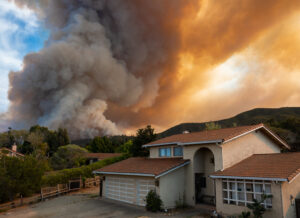 A new Research Paper from the Casualty Actuarial Society (CAS) [1] illustrates several use cases for catastrophe models to measure the effects of wildfire mitigation on homeowners and communities nationwide. The paper, “Catastrophe Models for Wildfire Mitigation: Quantifying Credits and Benefits to Homeowners and Communities [2],” provides a detailed analysis for understanding and quantifying the impact of wildfire mitigation on homeowners’ insurance premiums. It explores the need for catastrophe models to perform the quantification of mitigation efforts, outlining actuarial considerations and approaches for developing wildfire mitigation premium credits, and describes challenges in obtaining data and implementing mitigation premium credits. The paper illustrates these concepts through a detailed case study based on a specific community representing a significant concentration of wildfire risk in Northern California.
A new Research Paper from the Casualty Actuarial Society (CAS) [1] illustrates several use cases for catastrophe models to measure the effects of wildfire mitigation on homeowners and communities nationwide. The paper, “Catastrophe Models for Wildfire Mitigation: Quantifying Credits and Benefits to Homeowners and Communities [2],” provides a detailed analysis for understanding and quantifying the impact of wildfire mitigation on homeowners’ insurance premiums. It explores the need for catastrophe models to perform the quantification of mitigation efforts, outlining actuarial considerations and approaches for developing wildfire mitigation premium credits, and describes challenges in obtaining data and implementing mitigation premium credits. The paper illustrates these concepts through a detailed case study based on a specific community representing a significant concentration of wildfire risk in Northern California.
Authored by Peggy Brinkmann, Nancy P. Watkins, Cody Webb, Dave Evans, Gabriele Usan, Michael Glavan, Lillian Zhang, and Carolyn Prescott of Milliman Inc. [3]; and Tom Larsen and Grace Lee of CoreLogic Inc. [4], the Research Paper is intended as a blueprint to better understand the cost-benefit of mitigation premium credits and provides a methodology that stakeholders can construct to reduce the risk of wildfire.
“Well-understood and transparent systems for valuing risk provide a community roadmap to reducing both the probability of wildfire loss and the certainty of insurance rate increases or non-renewals,” said Dave Winnacker, Fire Chief of the Moraga-Orinda Fire District, California [5].
Focusing on a specific community in Northern California, the Paper contains three case studies. The first explains how an insurer could use a catastrophe model to set credits for individual homeowner mitigation actions. The second uses a modified catastrophe model to extend the analysis to reflect community-level understory fuel reduction mitigation. The third shows how model results could be used to quantify the benefits of various community-scale mitigation projects under consideration. The paper concludes with a discussion of practical considerations for insurers and communities engaging in this type of analysis.
“Wildfires are having a profound impact on communities, and Casualty Actuarial Society members have the insurance and risk expertise to help quantify mitigation efforts,” said CAS President Kathy Antonello, FCAS [6]. “Catastrophe models are a valuable tool to understand the interplay between different mitigation efforts and the cost-benefit of making these changes. Expertise from actuaries is key to understanding the results of these models.”
The CAS is an international organization for credentialing and professional education. Founded in 1914, the CAS is focused exclusively on property and casualty risks, serving more than 9,500 members worldwide. CAS members are experts in property and casualty insurance, reinsurance, finance, risk management, and enterprise risk management, and professionals educated by the CAS empower business and government to make well-informed strategic, financial and operational decisions.
Winnacker, added that the study, “represents an important step forward and provides a framework to value, and thus encourage, community-wide adoption of proven defensible space- and home-hardening mitigations that matter.”
While the study is intended as a blueprint and presents illustrative results only, wildfire risk and mitigation remains a complex topic that needs to be understood, communicated, and addressed by a variety of stakeholders including actuaries, catastrophe modelers, community leaders and fire experts, and policymakers.
“With California now enforcing new insurance pricing regulations, it’s more important than ever to understand and quantify the key variables that affect wildfire risk and how they relate to homeowner policy premiums,” said Watkins, FCAS, a Principal at Milliman [7], and co-author of the report.